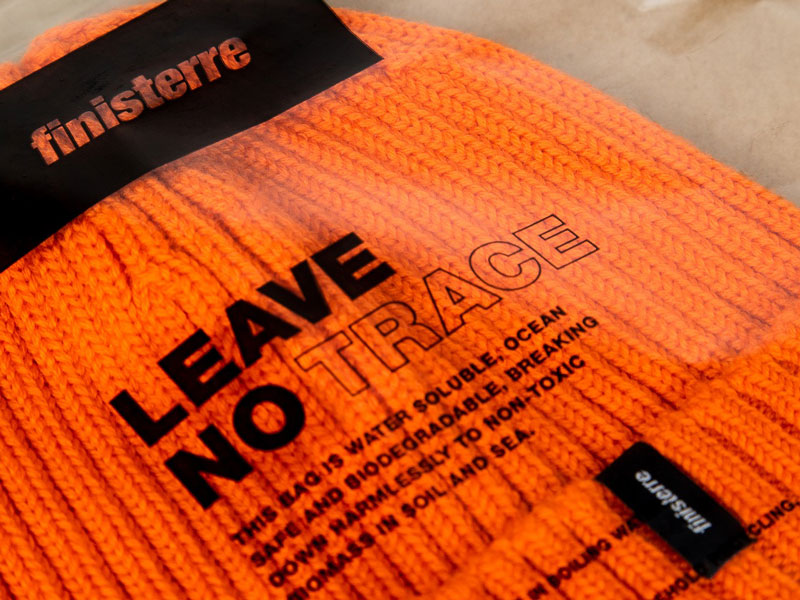Hydropol™ – The answer to fashion’s polybag problem.
Fashion and Retail brands have been looking for ways to eliminate plastic polybags for decades. It is estimated that 180 billion* (*Fashion For Good) polybags are used globally every year, and as a flexible plastic, the chances of them being successfully recycled is still less than 10% in many countries.
Lots of alternative materials have been tried but until now it has been extremely difficult to find a sustainable and scalable replacement for garment bags without compromising on performance, durability and functionality.
Hydropol™ was specifically developed to enable high performance next-generation packaging solutions that are also fit-for-purpose.
Our unique garment bags offer full functionality for brands and hassle-free end of life for consumers.
Practical Solutions
Durability meets Dissolvability

- Fully transparent for barcode scanning
- Lightweight with strength and durability
- High performance protection from spillages, dirt, humidity
- Tear/ puncture-resistant
- Proven to withstand the demands of shipping, packing, handling and transportation in a global supply chain
- Can be reused in supply chain multiple times
Tried and tested in global fashion supply chains








Hydropol™ superpowered garment bags
- Barrier to oxygen, grease, oils, fats, petrochemicals
- Shelf life of 2+ years
- Breathable to moisture
- Fully transparent
- Anti-static
- Strong, durable, puncture resistant
- Non-toxic: no product contamination
- Heat sealable
- UV resistant
- Printable
Barrier to oxygen, grease, oils, fats, petrochemicals
Shelf life of 2+ years
Breathable to moisture
Fully transparent
Anti-static

Strong, durable, puncture resistant
Non-toxic: no product contamination
Heat sealable
UV resistant
Printable

Worry free disposal for brands and consumers
Hydropol™ end-of-life options

Hydropol™ is formulated leave no trace in the environment regardless of how it is disposed.
It fully biodegrades leaving zero toxins or harmful microplastics and is safe for existing recycling or waste management processes.
Hydropol™ garment bags present zero end-of-life issues for consumers and brands.
They can be disposed of in existing domestic waste streams without contaminating other recyclable products or they can be dissolved immediately in hot water at home without producing harmful micro-plastics.

Watch how a garment bag can be dissolved in the sink at home
- RECYLING Hydropol™ bags dissolve in the recycling process without contaminating other recyclable material so can be placed in your normal recycling bin. We’re also working with brand partners to reuse, collect and recycle bags wherever practical.
- GENERAL WASTE Hydropol™ breaks down more quickly than traditional plastics in aerobic or anaerobic landfill without forming harmful microplastics or toxins.
- DISSOLVE AT HOME Hydropol™ bags can be dissolved at home in hot water (+70˚C) and will biodegrade completely in domestic wastewater systems. See our video below for details.
- COMPOSTING Hydropol™ bags are safe to be composted but please note the speed of home composting is often variable dependent on composting conditions.
End-Of-Life Testing & Certification
Download our End-Of-Life Testing Methods & Certification document to see the rigorous testing that proves Hydropol™ recyclability, biodegradability, and environmental safety.
Standard & bespoke bags from a global network
We work with a global network of packaging converters to support brands around the world. Our packaging partners offer multiple standard garment bag sizes as well as bespoke options to suit custom sizes or large garments.
The most commonly ordered sizes of Hydropol garment bags are shown below.

Simple and scalable
Hydropol™ is uniquely thermo-processable which means it is fully compatible with existing packaging manufacturing machinery and processes allowing converters to quickly integrate into existing production and switch over from conventional materials.
Hydropol™ was specifically developed and carefully formulated to provide a truly scalable solution to end the global problem of persistent plastic pollution from packaging. It does not rely on scarce resources or require the existing supply chain and recycling system to change dramatically to incorporate it.

Case Studies
Hydropol™ in Action:
Proven Success Stories
The brands below have proven it is possible to change,
take a look their stories and join the Hydropol™ packaging revolution.



